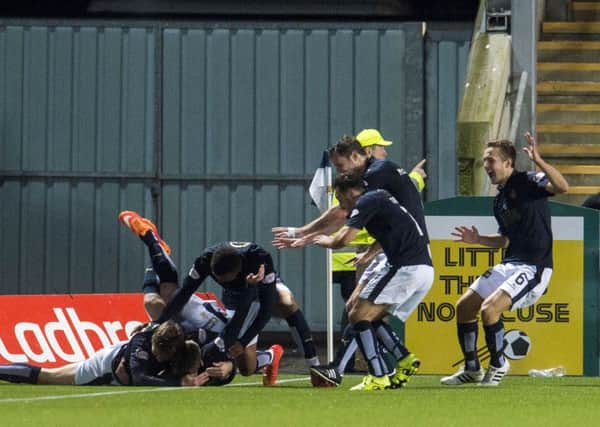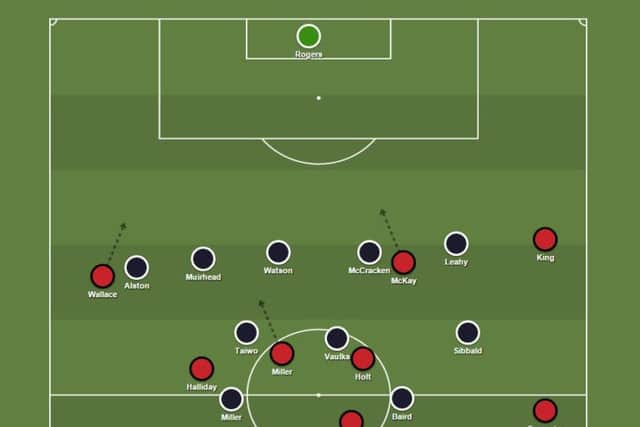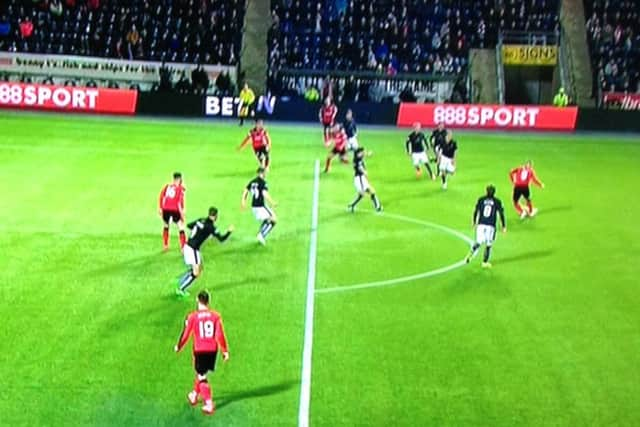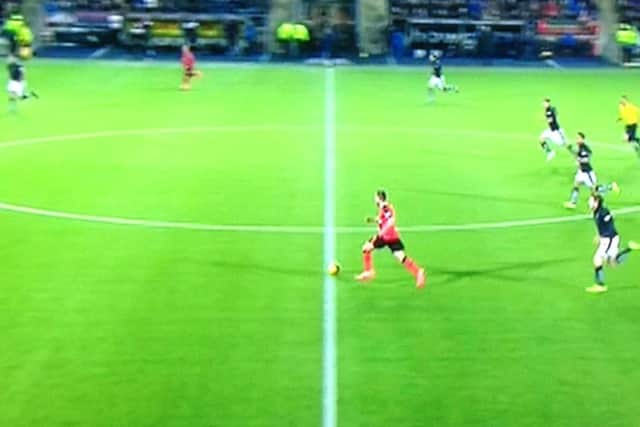How Falkirk made their epic comeback against Rangers
This article contains affiliate links. We may earn a small commission on items purchased through this article, but that does not affect our editorial judgement.


Considering their success against Rangers in previous encounters this season, Falkirk’s attacking approach to begin Friday’s game was curious. In both matches at Ibrox, where Falkirk battle valiantly, losing each only in the final 15 minutes, they lined up in a 4-5-1. This allowed them to crowd the centre of the park while having two wide players tasked with tracking Rangers’ rampaging full backs.
In the home match, which Falkirk won 2-1, they went with a 4-4-2 system, but deployed youngster Kevin O’Hara alongside top goalscorer John Baird. It gave the hosts pace at each of the forward positions, and this enabled them to take advantage of space left in behind by the Rangers rearguard. With both full backs going forward and Andy Halliday vacating his position as the defensive midfielder to join the attack, there was acres of space on the counter-attack for Falkirk, and they should have scored more in the victory.


Advertisement
Hide AdAdvertisement
Hide AdRangers decided to tighten things up after that defeat. No longer has it been common to see both full backs crashing the opposing penalty area at the same time. In front of the defence, Dominic Ball has sometimes been preferred to Andy Halliday, with the latter pushed further forward alongside Jason Holt. Ball is a natural centre back and therefore his focus is on more on the defensive side of the game.
Perhaps this is what dissuaded Peter Houston from starting with the same system that worked so well in the previous contest. Rangers had already witnessed this form of attack from Falkirk, and with the increased emphasis placed on the defence, maybe he thought the favourites would be ready for it.
What he went with was a 4-4-2 with Lee Miller up front instead of O’Hara. It may be a like-for-like replacement in terms of the position they play, but it makes a massive difference to how the team operate. Falkirk have used Miller intelligently this season. He’s not always started, but when he has they’ve often used him in tandem with John Baird, who benefits from having a target man to run off. Teams that like to sit in and deny space can be undone by the wily veteran and his ability to take the ball in tight areas, shield off defenders and link with team-mates. With Blair Alston and Craig Sibbald often starting on the wings, each of whom are centre midfielders with a tendency to drift inside rather than hit the byline, there’s enough options to create chances.
The issue with playing such a system against Rangers, and indeed any opponent with real weaponry on the counter, is that you need to shrink the pitch in order to get support to the less than mobile striker, which leaves a lot of space in behind.


The graphic in Image One is a representation of all outfield players at the point Kenny Miller releases Lee Wallace in the build-up to Rangers’ second goal. Your eyes should immediately be drawn to the gap between the back four and goal-line. It also represents how flat Falkirk’s starting system was in comparison to their dynamic visitors. With the exception of Alston tracking Lee Wallace, the three lines of defence, midfield and attack are clearly defined.
They struggled horribly in the opening 20 minutes with the movement of Rangers. Whenever one of the league leaders dropped or drifted into a different position - Miller coming deep to collect, Tavernier and Wallace going on the overlap, McKay drifting inside - the hosts were either slow to react or didn’t track the run at all.
Tactics only go so far in football. You also need players to execute. Image Two, which is a still shot of the wrongly disallowed goal, highlights how poor they were at reacting to Rangers’ movement in the opening exchanges. Sure, Falkirk’s starting system didn’t give them a great chance at victory, but the players didn’t defend in it as well as they should have. Sibbald was guilty of allowing Tavernier a free run inside at the disallowed goal, yet he didn’t learn his lesson and allowed the full back to do it once more for the opening goal.
Another issue in the first half revolved around the central midfield duo. During the last game between the sides at the Falkirk Stadium, Mark Kerr and Will Vaulks would largely sit in front of the defence, with Vaulks breaking out to support on counter-attacks. In this game, both Taiwo and Vaulks would drift forward at the same time, leaving a lot of space between midfield and attack. Rangers should have taken advantage of this at 2-0 (Image Three), when Billy King sprinted from deep in his own half before playing through Barrie McKay who squandered the one-on-one.


Advertisement
Hide AdAdvertisement
Hide AdMcKay’s miss would come back to haunt Rangers. Falkirk stopped the bleeding by moving into a 4-2-3-1 that became a 4-3-3 when they gained some confidence later in the match. At first, Baird moved out wide to track Tavernier, but without a mobile lone front-man they became completely ineffective in attack and a change needed to be made.
Myles Hippolyte was the inspired substitution. His attacking impetus caused Rangers all sorts of problems. He didn’t track the full back with the same discipline Baird had. Instead, he hurt Rangers with his willing to run at the Rangers defence and his positioning high up the park. He was effectively a wing-forward to the left of Baird, while Alston also pushed further forward on the right. You can see from the video, their advanced positions meant they were in the right places to take advantage of poor Rangers defending to net each of their first two goals. Hippolyte’s positioning also forced Tavernier to focus more on his defensive duties, and the full-back faded away as an attacking force. The narrowing of the midfield with the addition of an extra body also cut off a number of passing lanes and they were eventually able to deny Rangers the space in which to work. Interestingly, Falkirk’s tightening up at the back helped make them a greater threat further forward.
There was still an element of luck involved, as there always is in football. Rangers’ insensity faded and Alston’s goal, which gave Falkirk the belief they required, was a special strike that even a player of his quality won’t recreate too often. However, while he may have got the initial set-up wrong, Houston made the right changes necessary to keep his side in the match, allowing them to grow in confidence and take advantage of their visitors when they let their guard down.
THE SCOTSMAN ON SOCIAL MEDIA